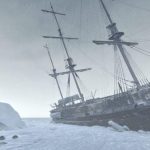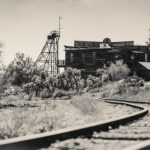 Creepy
Creepy  Creepy
Creepy  Technology
Technology 10 Scientific Breakthroughs of 2025 That’ll Change Everything
 Our World
Our World 10 Ways Icelandic Culture Makes Other Countries Look Boring
 Misconceptions
Misconceptions 10 Common Misconceptions About the Victorian Era
 Mysteries
Mysteries 10 Strange Unexplained Mysteries of 2025
 Miscellaneous
Miscellaneous 10 of History’s Most Bell-Ringing Finishing Moves
 History
History 10 Great Escapes That Ended Right Back in Captivity
 Weird Stuff
Weird Stuff 10 Fascinating Things You Might Not Know About Spiders
 Food
Food 10 Everyday Foods You Didn’t Know Were Invented by the U.S. Military
 History
History 10 Odd Things Colonial Americans Kept at Home
 Creepy
Creepy 10 More Representations of Death from Myth, Legend, and Folktale
 Technology
Technology 10 Scientific Breakthroughs of 2025 That’ll Change Everything
 Our World
Our World 10 Ways Icelandic Culture Makes Other Countries Look Boring
Who's Behind Listverse?

Jamie Frater
Head Editor
Jamie founded Listverse due to an insatiable desire to share fascinating, obscure, and bizarre facts. He has been a guest speaker on numerous national radio and television stations and is a five time published author.
More About Us Misconceptions
Misconceptions 10 Common Misconceptions About the Victorian Era
 Mysteries
Mysteries 10 Strange Unexplained Mysteries of 2025
 Miscellaneous
Miscellaneous 10 of History’s Most Bell-Ringing Finishing Moves
 History
History 10 Great Escapes That Ended Right Back in Captivity
 Weird Stuff
Weird Stuff 10 Fascinating Things You Might Not Know About Spiders
 Food
Food 10 Everyday Foods You Didn’t Know Were Invented by the U.S. Military
 History
History 10 Odd Things Colonial Americans Kept at Home
Ten Ghost Stories Below the Antarctic Circle
Barren. Desolate. Cold. These are a few words that people use to describe the continent of Antarctica. Not only is it the largest continent by land mass, but it’s also the largest desert, a 5.4-million-square-mile (14-square-kilometer) landscape devoid of life and all that sustains it. It wouldn’t require too much of a poetic license to call the landmass “haunting,” but as it turns out, that word may be a bit more literal than most people believe.
According to rumors, the continent of Antarctica is host to a slew of ghost sightings and haunting legends. Perhaps it’s the fact that the frigid wasteland has claimed the lives of many who attempt to explore it, or perhaps, that those who do perish on the continent tend to do so in a dramatic fashion. Either way, Antarctica is a hotbed for paranormal activity. According to legend, that is. Here is a list of ten ghosts and hauntings found below the Antarctic Latitude Circle.
Related: 10 Ghosts, Monsters, And Curses Of The American South
10 The Ghost of Lenin
Vladimir Lenin is most well known for being one of the most influential political leaders in the Soviet Union, up until his death at the hands of a stroke in 1923. At no point during his life was Vladimir Lenin an explorer of the South Pole, but despite that, it is claimed that his ghost lingers at a particularly haunting location; an old Soviet base discovered at the South Pole of Inaccessibility.
While Antarctica is home to the South Pole, the southernmost point of the planet isn’t in the direct center of the continent. The direct center of the continent, furthest away from the shore, is known as the Antarctic Pole of Inaccessibility. In 1959, the Soviet Union built a base there, though the building was buried in snow by the ’60s. However, a giant plastic bust of Vladimir Lenin watches over the site from above the snow drifts, even to this day. To make matters more mysterious, some claim to have seen the ethereal presence of Lenin floating about before the base ceased being used.[1]
9 The Ningen
Though a tad bit less-than-human, the humanoid cryptids known as the Ningen are nevertheless said to haunt Antarctica, of all places. These two-legged, armless beings look like a cross between a beluga whale and a person. Antarctica, however, lacks any sort of historical civilization, prompting the Ningen to only come into the cultural zeitgeist in May of 2002.
The legend began when online forums, primarily in Japan, started to circulate images of these whale-like people lurking in the waters of the Southern Ocean. The rumor gained traction when, in 2005, more images circulated of Ningen prowling the icy shores of Antarctica and getting picked up on Google Earth. As a result of the Ningen’s late entry into cryptid circles, these beings are often regarded as a host, though they do claim the fun distinction of being Antarctica’s most famous cryptid.[2]
8 Whaler’s Bay
When one thinks of Antarctica, a wintery wasteland is more prone to form in one’s mind before something like a volcano. Deception Island, however, is an island close to the Antarctic Peninsula that just so happens to be an active volcano. The last instance of an eruption only took place in 1970. According to some legends, though, lava isn’t the only thing someone should be wary of should they decide to take a trip to the island. Specifically, Whaler’s Bay is said to play host to ghosts.
Though a ghost town in the present day, Whaler’s Bay was a small community that housed whalers from Norway and Chile and was founded in 1904. What remains today are a few old wooden structures, a cemetery, and huge tanks once used to boil whole whales. Nowadays, the island is visited by tourists who witness paranormal occurrences, from hearing odd, disembodied noises to seeing even stranger ethereal, floating shapes. The SyFy channel even sent a crew out to investigate for their show Destination Truth.[3]
7 Wordie House
Sir Ernest Henry Shackleton is perhaps one of the most well-known explorers of the seventh continent in all of history, though he wasn’t the first person to reach the South Pole. The many expeditions that he led would result in him receiving a knighthood. His treks wouldn’t be without problems, though, and in 1915, he would be forced to abandon his ship, the Endurance, after it ran aground and found itself skewered by ice. Though Shackleton began a journey across the continent to find help, the remaining men would be stranded for two years.
Wordie House was the name given to a base that was constructed in 1947, and as it turns out, it was built close enough to where the Endurance found itself wrecked that people claim that the ship’s ghosts relocated there. Doors have been known to slam shut on their own, and objects will often fly across the room on their own. And some who enter the building report a strange, menacing presence watching over them.[4]
6 Air New Zealand Flight 901 on Ross Island
On November 28, 1979, Air New Zealand Flight 901 would tragically collide with Mount Erebus on Ross Island in Antarctica, leading to the death of all 257 people onboard. This would be later known as the Mount Erebus Disaster. The crash of the sightseeing plane is still New Zealand’s deadliest accident to this day, though the Antarctic scenic flight industry would recover afterward.
McMurdo Station, operated by New Zealand personnel, is Antarctica’s largest established base and also happens to be located on Ross Island. Some claim, however, that the restless spirits of Flight 901 have coalesced at the base, leading to reports of poltergeist activity similar to the Wordie House. Others also claim that the actual location of the crash sight itself is haunted. People claim to hear disembodied voices crying out, and others report seeing footprints form in the snow all on their own.[5]
5 The Operation Tabarin Base
The aforementioned Deception Island was more than a mere home for whalers. Even though the community would be left abandoned in the years before World War 2, the British Navy would reappropriate the area to use throughout the war. Though the use of the base was quite short lived, the British Navy would nevertheless build one for its Operation Tarabin in order to keep a stronger hold on the Falkland Islands.
Though the British bases would later be repurposed for scientific research, a volcanic eruption in 1967 would destroy a significant amount of the infrastructure on the island, prompting all remaining bases to become abandoned. Like Whaler’s Bay, the military structures have turned into a sort of ghost town where alleged hauntings occur. The activity mirrors Whaler’s Bay’s ghosts in how it manifests, with people reporting odd noises in the night and the shapes of apparitions moving. [6]
4 Scott’s Hut
In 1911, two different exploration teams endeavored to become the first group to ever reach the South Pole. Though the Norwegian expedition, led by Roald Amundsen, would eventually achieve that accolade, the British expedition, led by Sir Robert Falcon Scott, would be met with a different fate. Not only would they lose the race against Norway, but the five-man team would also pass away from falls, frostbite, and general exposure on the way back, including Scott himself.
A team of twenty-five men known as the Terra Nova Expedition would spend the winter of 1911 at the newest hut built by Scott, and it was from this group that the five doomed explorers would venture out. To this day, the structure is said to be haunted by the spirits of Scott’s team. The sounds of footsteps are heard in an otherwise empty room, voices come from places where no one can be found, and a plethora of people report a feeling of being watched.[7]
3 The Ghost Ship “Jenny”
In 1840, a British whaling vessel simply named “Hope” allegedly discovered a frozen schooner trapped in the ice of the Drake Passage near the South Shetland Isles. The men and women on the vessel were completely frozen and obviously dead. According to letters written by the captain, the ship, known as the “Jenny,” had been stuck in the ice since 1823.
Though no records have officially surfaced to this day, legend states that the crewmembers of the Hope returned to tell the tale of the Jenny, taking only the captain’s logs with them. They had no choice but to leave the frozen ship and its equally frozen crew behind, cast adrift at sea. Sightings of the Jenny would wriggle their way into the lore of seafarers who claimed to see the ship, or perhaps the ghost of the ship, silently gliding along the Southern Ocean for all of eternity.[8]
9 Shackleton’s Ghost Guides
Shackleton’s many Antarctic adventures once again feature on this list. One would be mistaken in thinking that the moored Endurance was the only hotbed for paranormal activity. According to legend, the journey that he made after the Endurance ran aground may have been entirely lost were it not for divine intervention.
A phenomenon known as the “Third Man Factor” is said to occur in situations wherein people are forced to survive extreme circumstances. People will report the presence of a nonexistent person, sometimes a guardian angel. In the case of Shackleton and his two companions, they all collectively witnessed a fourth member appear out of nowhere. In his journal, Shackleton wrote: “I know that during that long and racking march of thirty-six hours over the unnamed mountains and glaciers of South Georgia, it seemed to me often that we were four, not three.”[9]
1 The Ghost of Shackleton
The supernatural phenomena reported by Shackleton are one thing, but as it turns out, the Antarctic pioneer is rumored to live on as a ghost himself—”live on” being a loose term, in this case. And to add another celebrity to the story, the spirit of Shackleton was said to have been witnessed by none other than Sir Edmund Hillary, of Mount Everest fame.
A structure known as Nimrod Hut, or more often, Shackleton’s Hut, sits on the cliffs of Ross Island. It was in this building that Hillary claims that he saw the ghost of Shackleton himself. No dreadful ghostly feelings, no fading in and out of existence; the younger explorer simply witnessed seeing the long-dead Shackleton as a manifestation without any ghostly bells or whistles. The encounter so inspired Sir Edmund Hillary that he put a considerable amount of money toward the preservation of the structure.[10]








